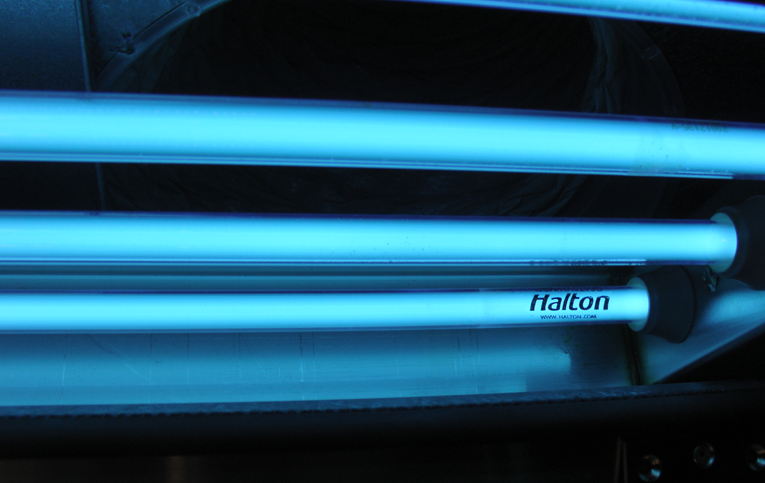Ultraviolet Lights or UV-C lights are a type of bulb that has a very high intensity that allows it to break down organic compounds. UV has been applied in a variety of sterilization and water treatment applications for decades. The wavelength varies by application. In the case kitchen exhaust systems, UV-C light is used to break down grease particles through two processes: photolysis and ozonolysis. The photolysis process breaks the molecular bond of grease whereas ozonolysis is a process that oxidizes the grease molecules.
The primary grease extraction for an exhaust hood is the mechanical grease filters in the hood. They work to remove grease particles by inertial means. The remaining smaller particulate and vapor are exposed to ultraviolet lights or UV-C light in the exhaust plenum. The result of this conversion is to reduce the fire risk by decreasing the grease buildup in the ductwork. It is important to understand that UV-C systems are not filtration systems. If the filtration of the remaining particulate is important, then a Pollution Control Unit (PCU) would be used.
There is a lot written about UV systems and their effectiveness. Generally, these systems are applied in applications where there is a high volume of cooking, and the mitigation of fire risk is paramount.
Tips for a successful UV installation in a commercial kitchen exhaust hood
For a UV installation to be successful, several things are necessary.
- Routine maintenance. Over time the UV bulbs will develop a coating from the converted grease. The bulbs must be wiped down periodically. Systems have usage timers that would indicate when routine maintenance is warranted. Also, one should monitor the initial maintenance cycle to determine if it should be increased or decreased based on usage.
- UV-C effectiveness diminished when exposed to temperatures above 160° F. Typical exhaust temperatures are in the range of 100°-120°F

UV installations have realized tangible reductions in cleaning costs and fire hazards.

UV-C systems are safety listed with several interlocks. One should take great care when handling UV systems and avoid direct exposure to the light. The primary grease extractors have an interlock mechanism (they vary by manufacturer) that work to ensure that when a filter is removed, the UV lights turn off. Also, there is an airflow proving devices to ensure the UV is not operating when the exhaust system is off.
Do you have any questions? Leave us a message below or please send your questions by using the “Ask the Expert“
For more information about Ultraviolet lights or UV-C technology and how it’s applied to kitchen exhaust hood visit www.halton.com by clicking here


Comments
9 responses to “What are UltraViolet lights in kitchen hoods used for and what outcome can I expect when using them?”
[…] The most effective combination of odor mitigation technology available. The UV lamps generate UV light which acts on the VOC’s and the carbon adsorbs them. The ozone from the UV lamps continues to […]
[…] Read more on UV technology and kitchen exhaust hoods by clicking on the link below: What are UltraViolet lights in kitchen hoods used for and what outcome can I expect when using them? […]
Dear.
I would like to know if you have distributors in Peru which i can contact to ask for information and support regarding UV lamps for kitchen hood. I am interested into consider those for a project that i am currently develping.
Best regards.
Pls contact for your request and information
[…] What are UltraViolet lights in kitchen hoods used for and what outcome can I expect when using them? […]
what will be the cost impact if I opt UV for my commercial kitchen hood?
Thanks
Hi Mak
The cost of UV depends upon extract flow rate, Hood size. Please send your inquiry at ajay.doliya@halton.com so, we can quote UV Hoods for your project.
I’ll be installing ecology unit with multi stage filtration system for my commercial kitchen exhaust network still do I need to opt UV in my kitchen hood?
Hi Mak Thanks for inquiry. The UV in Hood can help to neutralize grease at source and it will reduce number of duct cleaning cycle. If you have Ecology Unit with multi stage filtration and if you have grease application cooking such as Griddle, Fryer etc. then still it is recommend UV in Hood to deal with grease. The final decision should take by client about this.